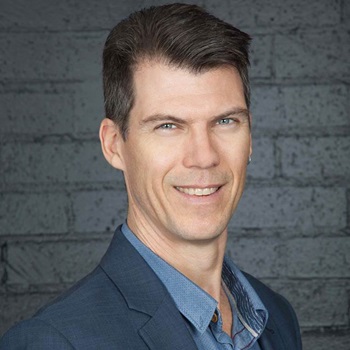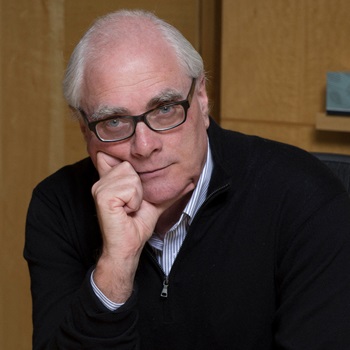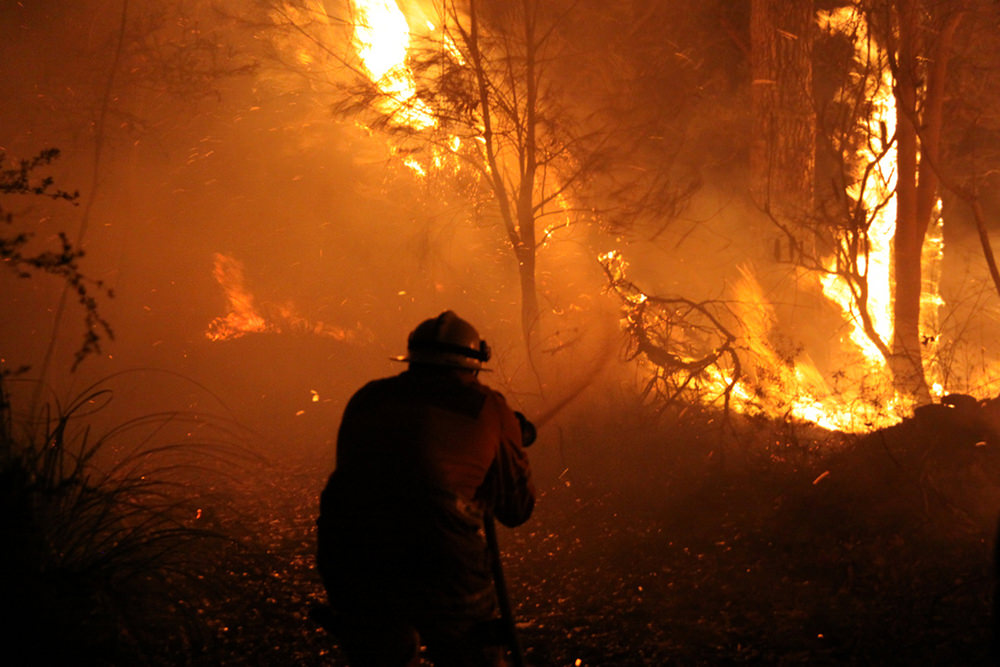From the Filmmakers

 Marcus Gillezeau, producer | Simon Nasht, Writer / Executive Producer
Marcus Gillezeau, producer | Simon Nasht, Writer / Executive Producer
(Ellenor Cox, Gillezeau's partner at Firelight Productions, was also a producer)
Bushfires – Inside the Inferno came about because different audiences have different needs
Simon Nasht: “The British production company Dragonfly Film and Television approached (SBS commissioning editor of documentaries) Joseph Maxwell and told him they were planning to make a presenter-led show on Australian bushfires for BBC Two. It was to be in the science and technology genre. Joseph told them it was something that could work for SBS – but not with British presenters – and that if they wanted to get their hands on Screen Australia money they would have to work through a local production company.”
Maxwell says he is regularly asked for information about the Australian production scene and the capabilities of Australian producers but, in this case, the production being discussed was at a more advanced stage than usual. He gave Dragonfly the names of several producers.
Nasht: “Dragonfly is part of the Shine Endemol Group and I understand that Shine Australia declined to get involved. But Shine International, the distribution arm, was on board. I had a series of discussions with Dragonfly and then recruited Marcus (Gillezeau) and Ellenor (Cox). There would be major logistical issues to do with scale, danger and protocols, and they have real experience shooting during the Australian bushfire season.” (The pair worked on the telemovie Scorched and the four-part documentary In The Line of Fire, both for the Nine Network. They too had been approached by Dragonfly, as had at least one other Australian production company.)
“Our simple rule” was to reveal new information
Marcus Gillezeau: “They wanted their presenters standing with a hose putting out a giant bushfire, but they had no qualifications to be in that environment. Our more realistic alternative was to get them into helicopters and trucks, in other words, into more controlled situations.
“The British mandate was to make a pure entertainment show; shot, cut and shown in a short time. Ours was to make a show about the science of bushfires in the national interest of Australian audiences and Australian taxpayers. We couldn’t have British presenters talking about bushfires to an Australian audience and working with scripts written through a British lens. Our audience was knowledgeable about bushfires so our simple rule was that we had to reveal information they definitely didn’t know. Our documentary also had to be timeless – a historical document you could watch in 100 years – and the information it contained had to be rigorously tested.”
Nasht: “For 15 years my specialty was complex co-production. A recurring issue is that one partner thinks “our film, their money”. It’s about coming to an inevitable but often difficult compromise.
“We were the senior partner in editorial terms but Dragonfly had big overheads to cover – meaning office expenses but it was also about their expectations. In the UK there are long-established terms of trade which allow production companies to take a minimum of 10 percent of the budget as a fee, whereas that’s never been allowed in Australia. The British wouldn’t get out of bed for less than 10 percent! In Australia overheads are capped at five percent. It equates to making the program at cost.
“Internally, UK producers will run productions with an eye to a built-in profit margin, although in this case, as the production was not fully financed by presales, the distributor stepped in to fill a gap. We weren’t privy to their internal accounting arrangements but I am assuming the producers were still able to take their margin — and that’s smart business.
“They were alarmed at our production costs and wages when converted into pounds: the Australia dollar was at parity with the US dollar at the time we were filming. Like the movie business, TV co-productions are hostage to the exchange rate.
“Overall, each of us ran our own budget on our own show and the plan was to share costs wherever it was feasible.”
“The standard budget for high quality, deeply researched traditional blue chip documentary is $650-$750,000 per hour … Typically, an international distributor will provide a $10-25,000 per hour advance for a 10-year term … The SBS license fee was at the standard floor price of $150,000 per hour”
Marcus Gillezeau
Advances have “been the same for a decade”
Gillezeau: “The standard budget for high quality, deeply researched traditional blue chip documentary is $650-$750,000 per hour. We can’t completely spell out our budget because we’re not at liberty to give you Shine International’s distribution advance, but I would describe the advance as standard. Typically, for a blue chip documentary, an international distributor will provide a $10-25,000 per hour advance for a 10-year term. It’s been the same for a decade because the license fees that broadcasters are paying distributors are falling.
“It was an unofficial co-production, with the British version sitting quite separate to our finance plan. The SBS license fee was at the standard floor price of $150,000 per hour, giving the broadcaster four primary channel runs over five years. Screen Australia provided investment of $250,000 per hour and we got a $30,000 grant from Screen NSW’s regional filming fund and a further $60,000 in production finance, also as a grant. The Producer Offset (PO) was also a major contributor.
“We had to get going quickly because we were well into the fire season by the time we started and Shine did a vital thing, which was to cash flow early production. This was repaid once contracting was completed in mid-2014.”
Screen Australia’s investment was under the National Documentary Program (NDP), but this program has since been replaced. For info on the agency’s current documentary funding policies go here
When the PO is applied to television and non-theatrical documentaries it is worth 20% of qualifying Australian production expenditure (QAPE). The PO is administered by Screen Australia. For information on eligibility, QAPE, the process of applying, etc, go here
 Bushfires - Inside the Inferno
Bushfires - Inside the Inferno
Care needed to calculate QAPE
“Two of our British colleagues were out here for a week of initial research in October 2013. They came again for a couple of weeks of pre-production later in December. Five people in addition to the presenters came for filming: two executive producers, the series producer, a director separate from our director, Max Bourke, and the researcher who came out during pre. They were here for a month but we kept filming until May. They also shot some footage in the UK and the US. It all happened pretty quickly.
“Our crews were servicing their needs but after day two of the shoot we largely had two crews working in parallel. It worked out fine once it was understood that we were effectively fulfilling a service requirement for a British company while producing a separate domestic version as per any commission.
“There were bushfire shoots – and bushfires could happen at any time – and science shoots. The original idea was that the Brits would interview the experts and we would be able to use that interview footage or continue with questions more relevant to an Australian audience. But we underestimated the time it took to do these interviews and how much they wanted the presenters to be in shot. Realising we would have to produce something quite different for SBS, we rationed expenditure as best we could until they left and then went back to a lot of the same interviewees. We had also allowed for a healthy contingency because we knew there would be multiple exigencies from both a physical production and a producing point of view: we had to budget for them and anticipate them in terms of the story and the reality of shooting in completely unpredictable situations.
“Their research really helped us and we had a footage exchange arrangement where they could use ours and we could use theirs. We probably used 10-20% of the material they shot.”
Nasht: “In other words, the two versions diverged very quickly and substantially. They were making a presenter-led program (with UK TV stars Kate Humble and Simon Reeve) and we were not using presenters so they were not delivering what we wanted and we had to suck it up. You can’t go to a commissioning editor and say ‘the fault rests with our co-producer’.
“They did what every good producer does: deliver what he or she has to. Producing is about self-interest and survival – and hopefully success. That’s not a criticism. They were used to full budget commissions and doing things their way. They had little experience of co-production and had a crisis of control because they had to trust us without having worked with us before. I would be the same. They were also overwhelmed by the sheer scale of the geography of Australia. And there were very serious safety issues. They weren’t aware that you can’t fly crews into fire zones and expect to get them out on the same day.”
Gillezeau: “We managed to successfully turn what could have been a standard service job into an international production with domestic and UK finance. Once we worked out what each of us needed, we worked quite well together. Would I do it again? Of course.”
“They did what every good producer does: deliver what he or she has to. Producing is about self-interest and survival – and hopefully success.”
Simon Nasht
“We were effectively working for fees”
Nasht: “Smith & Nasht retains all rights in Australia and New Zealand, but apart from some OK DVD sales, we were effectively working for fees. Shine is selling our version internationally, but it will take a long time to recover the advance, so we do not anticipate any pot of gold.
“From the Shine family we got a significant advance, equity and, as Marcus said, cash flow for the production, which is unusual. The reality is that once a big distributor is deficit financing a production in this kind of way, the chances of getting significant revenues are limited. It has always been thus.
“However, speaking generally, the opportunities of transactional video on demand do offer producers another revenue stream, and we will wait and see how this evolves. As ever, the battle will be about retaining the appropriate rights.”
“We know it will take a lot of work to market a production online and so we have invested in a separate company, Screen Impact, to specialize in this. Marcus and I are already working together on our next co-productions and we are optimistic that it will finally offer what the Australian industry has been lacking: a sensible return on the incredible effort that goes into making high-end production.”
Episode one of Bushfires – Inside The Inferno attracted 346,000 viewers; episode two, 308,000 viewers. These figures do not include SBS on Demand or repeat viewing.

What to read next
WildBear Entertainment was prompted to produce Making Tracks by a commissioning editor at German public broadcaster NDR.
31 May 2016
Sandy George